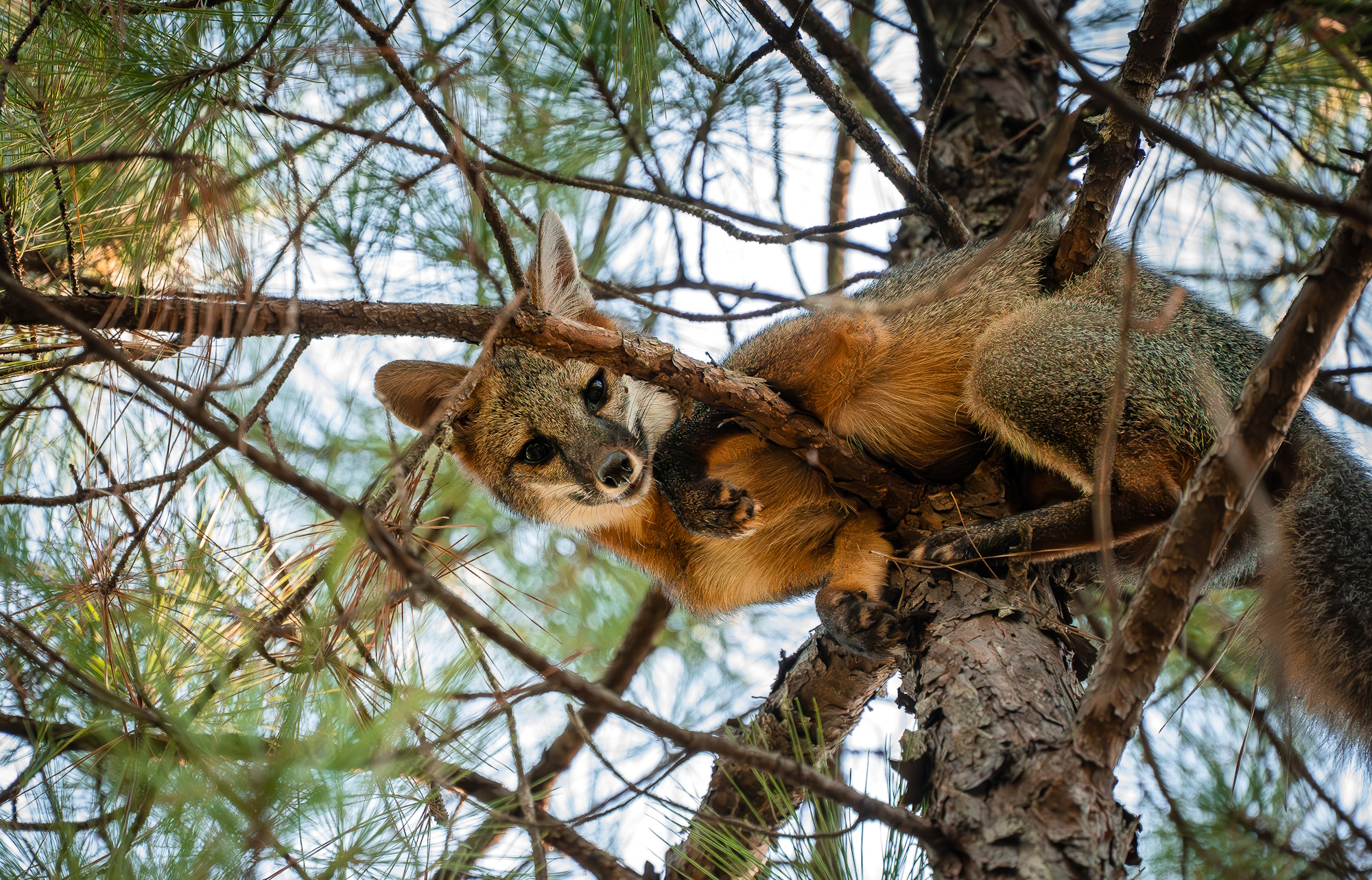
By Terry W. Johnson
Although the gray fox is the most common fox in Georgia, it is truly a will-o’-the-wisp. Two of the main reasons why are that this fox is shy and far more active at night than during the day. Consequently, the only time most of us see one is when it darts through the beams of our headlights and quickly vanishes into the dark as we drive down a country road or suburban street. While I consider these far too infrequent events very special, the encounter I long to experience even more is seeing a gray fox perched in a tree.
Yes, as odd it may seem, the gray fox does indeed climb trees.
This Georgia native is one of only two members of the canid or dog family that climbs trees. The other is the raccoon dog, a strange critter native to East Asia. Therefore, it is not surprising that the gray fox is also known as the tree fox.
This fox has a number of anatomical attributes that allow it to ascend to heights of 70 more or feet. To begin with, it has short legs and semi-retractable claws. (Its claws are so catlike some also refer to the gray fox as the cat dog.) Being semi-retractable, the claws don’t wear down as do those of other canines such as the red fox. The sharp, curved claws can dig deep into a tree trunk and limbs and allow the animal to climb with ease. They also provide a strong hold when the fox decides to descend to the ground.
The animal also has powerful hind and forelegs that allow the gray fox to push itself off the ground and while tightly holding onto a tree. Those who have watched a gray fox climbing a tree often say it reminds them of how a black bear climbs, tightly grasping the trunk with its forefeet and legs while pushing up with its hind legs. The muscular legs also enable the fox to move about in the tree canopy and even jump from limb to limb.
The gray fox has flexible ankles, as well. These help with climbing and moving about the tops of trees. They also help when chasing prey or trying to escape a predator, allowing the fox to quickly change direction.
The gray fox can descend either head or tail first. Either way, it’s more adept at climbing up than going down. As such, sometimes a fox will injure itself during its descent. A gray fox may slowly descend tail first (a technique often employed by cats). However, this fox can climb down, too, by jumping from limb to limb. When descending a sloping tree it will also seemingly run down the trunk of a tree. When going down vertical tree trunks, the gray fox usually holds its head up and relies heavily on its forelegs to lower itself.
There are many reasons why gray foxes climbs trees. One is to escape predators, such as when pursued by dogs or coyotes. In fact, some biologists suggest that the gray fox’s ability to climb might lessen the impact of coyotes on their populations.
Gray foxes have also been seen resting and even sleeping in the tops of trees. Sometimes they use old hawk and owl nests to take a siesta.
Although rodents are one of the main foods in its diet, the gray fox will also eat squirrels, birds and bird eggs found in trees. They’ll even climb trees to feed on fruits, berries and nuts.
Gray foxes raise their young in tree cavities located high above the ground. In addition, gray foxes will climb trees while playing. I recently watched a video online that showed a family of gray foxes running up and down a couple of mature hardwood trees in a backyard.
I have long thought that I would one day see a gray fox peering down at me from one the large trees growing in my yard. While that has never happened, several years ago I did spot a gray fox trotting across my lawn. The fox and I both stopped at the same time. For a few brief moments, I looked deep into the eyes of this beautiful wild animal. Then it resumed trotting across the yard, leaving me with a memory I will never forget.
I am amazed that after spending a good portion of my career as a wildlife biologist, as well as hunting and wildlife watching throughout many of Georgia’s wild places, that I have yet to see a gray fox in a tree. It makes me wonder if I ever walked beneath a tree harboring a gray fox and did not realize it. I know one thing: I now take the time to peer into the tops of trees whenever I am afield or simply exploring my backyard.
Terry W. Johnson is a retired Nongame program manager with the Wildlife Resources Division and executive director of The Environmental Resources Network, or TERN, friends group of the division’s Nongame Conservation Section. (Permission is required to reprint this column.) Learn more about TERN, see previous “Out My Backdoor” columns, read Terry’s Backyard Wildlife Connection blog and check out his latest book, “A Journey of Discovery: Monroe County Outdoors.”




















